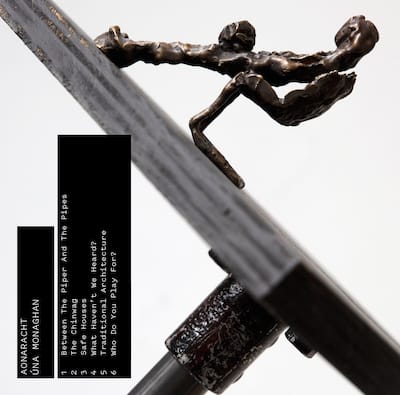Úna Monaghan
Aonaracht
Self Released
2023

Aonaracht means ‘solitude’ or ‘singularity’ in Irish, and that name is telling. Úna Monaghan’s latest album is a negotiation of space, for both the traditional solo musician and the computer. Even though we often associate traditional music with group playing, the Northern Irish composer reminds us that music is about self-expression and uses her work to explore the personal relationship between the musician and their instrument. Úna Monaghan uses electronics in her songs to see if something will emerge from beyond the music, to uncover the hidden layers of the relationship between the musicians that worked on the album (Paddy Glackin, Saileog Ní Cheannabháin, Tiarnán Ó Duinnchinn, Pauline Scanlon, and Jack Talty) and their instruments.
The collection kicks off with Between the Piper and the Pipes (Music It Might Have Been, But Piping It Certainly Wasn’t). The first few minutes are an introduction, with sounds reminiscent of a musician sitting down and getting comfortable with his instrument – something like a creaky chair, fingers on wood. Some parts of the song place the listener firmly in a traditional pub with a soloing piper (courtesy of Tiarnán Ó Duinnchinn on uilleann pipes). At other times, the listener is left wondering at the dissonance, the white noise, the places Monaghan is taking them seemingly at random. However, the experience is so captivating that you don’t question the disorienting synths. You’re following the Pied Piper.
The Chinwag then feels like a return home. The harp, that Monaghan is so masterfully playing, weaves together a sweet landscape, and you can imagine sitting at home and sipping tea. The sound artist manipulates what was a conversation between three elderly women in a house in rural Donegal, using pitch detection and motion sensor, and the robotic voices seem somewhat unsettling. Until the second half of the song, when the women can be heard talking about emigration, funerals, and rose bushes. The song forces the listeners on a journey of discovery, and by uncovering layer by layer, we’re getting closer to the truth.
It was clear from the outset that Monaghan is a pioneer. She proves that again in her third piece, Safe Houses, with the use of Folk-rnn, an AI that generates folk tunes (the concept of technological singularity is prominent here). This song is an exchange – three of the pieces written by Folk-rnn are given to the concertina player, Jack Talty, while Monaghan plays a piece composed by herself on the computer while learning the workings of Folk-rnn. In both cases, she states, tunes can be composed after learning from an established collection.
What Haven’t We Heard shows the gripping power of words and the voice, setting Maureen Boyle’s poem ‘Weather Vane’ to music. Here, Pauline Scanlon sings about a mother in a Mother and Baby Home, describing a scene where she has to clean the moss off a roof six months into her pregnancy as a punishment for her vanity. Electronic textures swirl around the vocal and the harp, and Scanlon switches to vocal improvisation sounding her lament, while the electronics become more and more prominent, giving one the feeling of being trapped, which, of course, is exactly what this song is about. Even in a piece with lyrics, Monaghan succeeds in doing more showing than telling. The liner notes share that the live version of this piece, originally written in 2017, is performed with additional sections. It explores wider themes of gender balance in Irish traditional music, imagining the notes of a tune as voices, and what we might hear when those voices aren’t equally represented. For more information on the research that followed, see Úna’s article in Ethnomusicology Ireland “121 Stories: The Impact of Gender on Participation in Irish Traditional Music” (2021).
The magnum opus of this album, Traditional Architecture, clocks in at just under 20 minutes. The sudden interruptions, the swishing and swirling of electronics like a ship at sea, and the mood change seems to suggest the piece’s underlying themes. Monaghan didn’t only attempt to explore the piano’s range, texture, and the interruption of space. For Traditional Architecture, the piece quotes from seven melodies from Irish poet Thomas Moore’s’ Irish Melodies’, arranged by John Stevenson; and seven corresponding traditional melodies in Saileog Ní Cheannabháin’s arrangement. In an elegant way, Monaghan explores the theme of colonialism and what happens when someone takes existing material and changes it.
Everything comes together in Who Do You Play For? with the exquisite performance of Paddy Glackin on the fiddle, interwoven with excerpts from “Last Night’s Fun” by Ciaran Carson and Cathal Ó Searcaigh’s new poem ‘Orpheus na gCnoic’. The listener steps into the shoes of the traditional musician, listening to phrases such as “play that one I can never remember/ play that one from Titanic”. It’s about the places they play, the different contexts they find themselves in, and the whirlwind of the artform. The piece is a response to the unpredictability of music, and of life.
Listening to Úna Monaghan’s Aonaracht is like stepping into a world of her own making. You must suspend disbelief for a while and enjoy the journey Monaghan has mapped out for you, for she is playing by her own rules. While they might not be followed in the regular world, the universe she has so carefully constructed is thought-provoking, graceful, and complete, so why would you ever leave?
Order Aonaracht via Bandcamp: https://unamonaghan.bandcamp.com/album/aonaracht
You can also hear a track from Aonaracht in our Folk Show – Episode 129 here.

